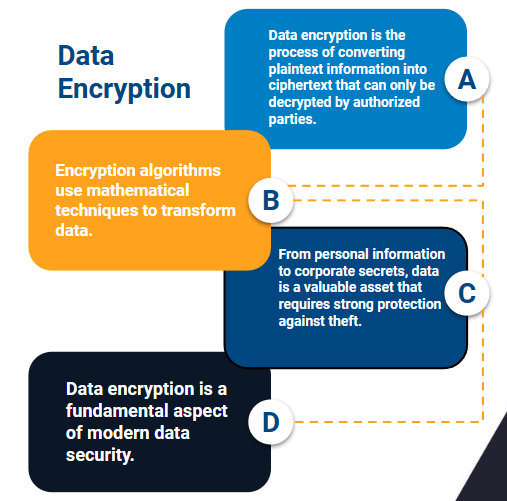Setting up data encryption strategies: protecting your digital assets
October 27, 2023
Table of contents
Quick Access

Security and prevention in a software product are critical for its proper operation, especially if it contains sensitive data and information. One of the most popular services in cybersecurity is data encryption, which is responsible for "hiding" the information so that it is not vulnerable to leaks or theft.
According to Statista, "the average cost of a data breach in the United States in 2023 will be $9.48 million, up from $9.44 million the previous year." In 2023, the global average cost per data breach was $4.45 million." This demonstrates the significance of having an encryption and data protection plan.
This post will go over the fundamentals of using data encryption solutions to preserve the security and integrity of your data.
What is Data Encryption?
The process of transforming plaintext information into ciphertext that can only be decoded by authorized individuals who have the decryption key is known as data encryption. Encryption methods use mathematical techniques to change data, rendering it unreadable to anyone who does not possess the appropriate key.
This technology has become a cornerstone of data security, with applications ranging from data at rest to data in transit to data in use.

Key Elements of Data Encryption Strategies
- Data Classification: The first step in developing an encryption strategy is categorizing your data. Not every data requires the same amount of safeguarding. Begin by identifying sensitive data, such as personal information, financial records, intellectual property, and private corporate data.
- Data encryption at rest: It is critical to protect data when it is stored on devices or servers. Common methods include full disk encryption, file-level encryption, and database encryption. Based on the classification of your data, select the suitable encryption method.
- Encrypt data in transit to keep it safe as it travels across networks. TLS and SSL protocols are routinely used to encrypt data during transmission, ensuring it remains confidential and tamper-proof.
- Data-in-use encryption is a more advanced form of encryption in which data is encrypted as it is processed or used by programs. Calculations can be conducted on encrypted data using techniques such as homomorphic encryption without disclosing its contents.
- Optional encryption algorithms: For optimal security, use powerful encryption techniques such as Advanced Encryption Standard (AES). To protect against vulnerabilities and exploits, keep your software and encryption libraries up to date.
- Key Management for Encryption: Proper key management is critical. Generate, store, and distribute encryption keys in a secure manner. Implement key management role-based access control to limit access to authorized personnel.
- Access Controls and Authentication: Implement stringent access controls and authentication measures to limit access to encrypted data. Strong password policies and multi-factor authentication are essential.
- Auditing and monitoring on a regular basis: Monitor and audit your encryption technique on a regular basis. This aids in the detection of vulnerabilities, abnormalities, and unauthorized access in real time, allowing for rapid corrective action.

Data encryption in practice
Knowing the principle of good data encryption to safeguard confidential information, it is time to see how it may be successfully utilized in a mobile or online application.
Consider the following scenario: a healthcare organization that controls patient medical records. To safeguard the confidentiality of this sensitive information, this organization is mandated with strong data protection regulations. Patient medical records are classified as highly sensitive data that requires strong encryption by the healthcare company.
To accomplish the latter, the business employs full disk encryption on all servers and workstations where patient records are stored. It also uses database-level encryption to safeguard data within its database systems.
In the event of a medical organization, data in transit encryption may be required. TLS encryption is used on the organization's network connections and web apps to protect data as it is sent between healthcare facilities and during telemedicine sessions.

Access Controls and Authentication are advised as an additional security measure. We use multi-factor authentication and role-based access controls. Access to patient records is restricted to authorized medical staff, and all access is logged for auditing purposes.
The team in charge of encrypting data must conduct auditing and monitoring on a regular basis. To maintain compliance and data security, the team continuously monitors the organization's or company's encryption systems and conducts regular audits and security assessments.
Data encryption is a critical component of modern data security, and implementing the proper encryption strategy is critical to protecting your digital assets. You may develop a robust defense against data breaches and illegal access by properly classifying your data, selecting strong encryption solutions, and implementing effective key management, access restrictions, and monitoring.
A well-executed encryption plan is the key to data security in today's digital age, whether you are a healthcare organization protecting patient records or a corporation protecting financial transactions.
We recommend you on video
Related Blogs
Free Magento Commerce Features for an Online Store

How to use chatbots for e-commerce?

Which API is best for Android App Development Services

How to automate processes with Odoo software
What programming language is used with React Native?

